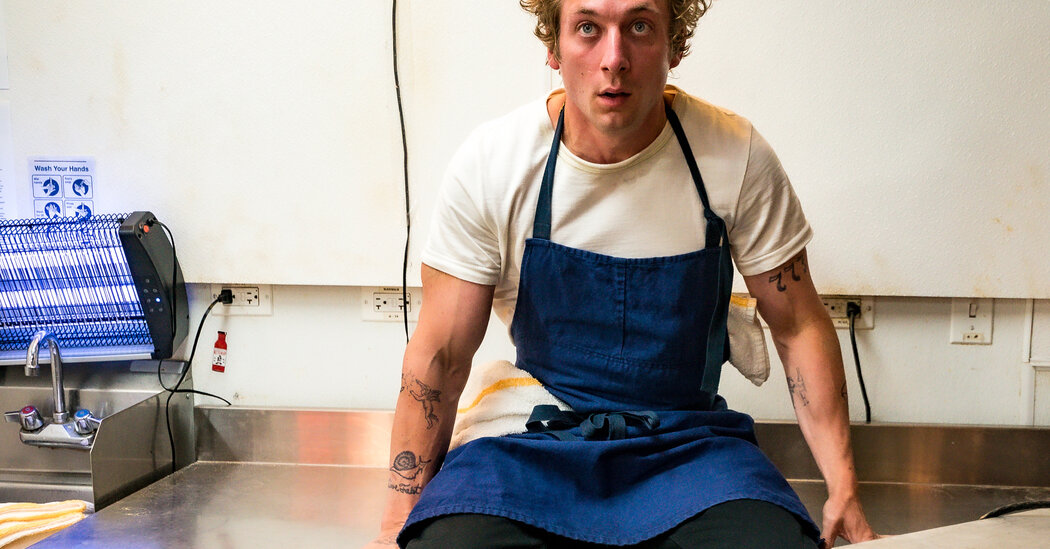
Movies and TV shows about the inner workings of the culinary world have let us peek into restaurant kitchens before. But FX’s new “The Bear” is the first to force you to work in one.
As the series (streaming on Hulu) opens, the young chef Carmen Berzatto has left behind a soaring career, replete with awards like the James Beard Foundation’s Rising Star, at an unnamed high-end New York restaurant (played by Eleven Madison Park). He’s come home to Chicago to run his family’s Italian beef sandwich shop after his brother Mikey died by suicide, leaving a $300,000 debt but no note. The monumental task of keeping Original Beef of Chicagoland afloat while trying to grieve his brother, retain his employees and make good food is eating him alive — and the show makes you feel you’re right alongside.
To review: Chicago’s Italian beef is one of America’s great sandwiches, with its thin-sliced roast beef, tangy giardiniera and roasted peppers piled on a submarine roll, then drizzled with or dipped in beef juices. It’s wrapped in paper and eaten in what locals call “Italian beef stance” — feet planted wide, elbows on the counter, butt sticking out to escape the inevitable pickle tumbles and jus drips.
Instead of supervising trained cooks as they tweeze herbs and zest yuzus, Carmen is now running on a hamster wheel of tasks: dicing carrots, breaking up fights and peddling his vintage denim collection to buy meat. (Throughout, the camera’s tight shots and jump cuts and the audio’s loud drone give you the sense of being in the room.) Instead of deferential interns, he inherits a prickly crew, loyal to his brother’s memory and his spaghetti recipe, plus a rageful, grieving manager (and childhood friend) who taunts him by calling him “Bobby Flay” — and much, much worse.
As chefs have moved from being invisible workers to celebrity artisans and influencers, there have been many attempts to make them stars onscreen. Movies such as “Chef” (2014), “Burnt” (2015) and “Pig” (2021) did it with varying degrees of success, depicting chefs as profound, tortured geniuses. On television, real-world chefs like Missy Robbins, Wylie Dufresne and Alex Guarnaschelli are frequently featured on “Billions,” and global stars like Alex Atala and Dominique Crenn are profiled in worshipful series like “The Mind of a Chef” and “Chef’s Table.”
But for all the media representation of the restaurant world, “the track record on authenticity is not great,” said Christopher Storer, co-showrunner of “The Bear,” who produced multiple documentaries about the culinary world before turning to fiction with “Eighth Grade” and “Ramy.”
His friend the Canadian chef Matty Matheson, who produced and consulted on the series and wound up playing a small part, said he wanted an accurate, unpretty representation of what he calls “this amazing, beautiful shitty industry.”
Some of the series’ accuracy comes from being shot in a real kitchen. One of Mr. Storer’s best friends from childhood, Christopher Zucchero, is Italian beef royalty; his father and uncle opened Mr. Beef on North Orleans Street in 1978, and he’s now an owner. Most of the scenes at Original Beef of Chicagoland were shot in its kitchen: a typical warren of small rooms, functional but grubby and full of hazards: tight corners, sharp knives, high shelves and hot pans.
Its most authentic feature is also the first thing Carmen sees when he jolts awake: the clock, the absolute ruler of any kitchen. No matter how fast he works, he can’t change how long it takes to caramelize onions or get bread dough to rise. Likewise, he can’t replace 30 gallons of stock that took days to make when a container spills in the walk-in. The countdown to opening time is inexorable.
“The stress is real, whether it’s fine dining or Italian beef,” said Courtney Storer, Mr. Storer’s sister, who worked her way through high school at restaurants in Chicago, where they were born and raised.
She went on to culinary school and later cooked for eight years at the acclaimed Los Angeles restaurants Trois Mec and Animal, and also consulted on the series.
The Storers said that the show’s themes of family, addiction, obsession and recovery draw on both their own history and their intimate knowledge of life in professional kitchens, high- and low-end alike.
The actors worked unusually hard to study the elite corner of the culinary world that Carmen has returned from. Jeremy Allen White, who plays Carmen, and Ayo Edebiri, the intern sous chef who is the only other character from Carmen’s world, both went through basic training at the Institute of Culinary Education in Los Angeles. Mr. White went on to work at Pasjoli, the Malibu restaurant headed by Dave Beran, Grant Achatz’s longtime lieutenant at Alinea in Chicago.
Lionel Boyce, who plays the bread baker, went to Copenhagen to study with Richard Hart, the British sourdough whisperer who helped build Tartine in San Francisco before René Redzepi recruited him to make bread for Noma in 2017. (Noma’s cookbooks are the only ones we see in use in the kitchen, though it’s possible to spot a set of “Modernist Cuisine,” and there’s a copy of Julia Child’s “Mastering the Art of French Cooking” in a corner of the office.)
But onscreen, the kitchen crew are resistant to Carmen’s upgrades: There’s fennel in the giardiniera, the beef is braised instead of roasted and even the rolls are tweaked for elasticity. (It takes a lot of gluten to stand up to the juices of a proper beef sandwich.).
What he’s really trying to do is harder than changing recipes: He’s rebuilding two dysfunctional families in mourning — his own and the restaurant’s.
Carmy’s sister is married, living a middle-class life in the suburbs, and wants nothing to do with the beef business; she can’t even stand the smell of the place. He can’t talk about his grief with her, but when he starts going to Al-Anon meetings (Mikey was addicted to opioids), that’s a love language she understands.
To fix the kitchen, he brings in the practices of an (idealized) fine-dining restaurant. Starting with making the cooks call each other “chef,” he establishes mutual respect and a clear chain of command, and opens doors to new skills. (With some mayhem along the way, courtesy of a new digital takeout ordering system.)
“You see the change progress over the series,” Ms. Storer said. “Everything about the cooks changes: The way they carry a towel, hold a spoon, wear an apron.”
Of course, because this is fiction, the chef successfully transforms his ragtag crew into a tightknit band: a literal brigade, once a traditional French culinary hierarchy is put into place.
But unlike many onscreen journeys, because of the show’s balance of bitter and sweet, this one doesn’t feel cloying.
The only time I thought I spotted a culinary off-note was in the fourth episode. Mashed potatoes are going on the menu, and Tina, the sharp-tongued, softhearted vegetable cook, has just pulled a sheet pan of whole potatoes from the oven. She’s struggling to peel them while still hot, then whip them by hand. The whole operation seems wildly impractical for a professional kitchen, where they would be boiled or steamed.
“Yeah, that is a crazy way to make mashed potatoes,” Mr. Matheson confirmed. He said he pulled that episode from his own life, working at the classic Toronto bistro Le Sélect. Out of tradition and stubbornness, the old-school French chef in charge at the time insisted on it.
“Sometimes chefs make you do things for no reason,” he said. “Learning to suck that up is part of the job.”




